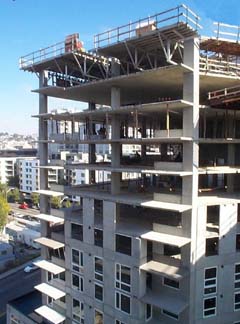
Awards
DJC.COM
May 3, 2002
A solid future for concrete design
Cary Kopczynski & Company

Kopczynsk |
In 1947, the American Concrete Institute (ACI) proudly issued its latest edition of the ACI 318 Building Code — 64 total pages in a modest 5-by-8-inch format. Just last month, ACI released its newest version of the 318 Building Code.
It’s grown.
It now encompasses a whopping 443 pages in 8-1/2-by-11 format. That makes the 2002 code roughly 16, that’s right — 16 times — bigger than the 1947 version!
This begs several questions. What is causing this exponential increase in size? Is runaway growth likely to continue? Are buildings and other structures designed to these new codes better? And finally, what is the impact of this mushrooming data on the construction industry?
Let’s examine these questions one at a time. Before we do, however, it’s important to note that all in all, the industry is benefiting from these changes. To be sure, challenges exist. And, they will continue to be successfully met.
Code development

Photo courtesy of Cary Kopczynski & Co. The Olympus in Belltown was designed using a performance-based approach and incorporates a cast-in-place concrete frame with post-tensioned floors and cantilevered balconies. Exterior cladding is a combination of precast and cast-in-place concrete. |
Code development is being driven by the twin engines of the knowledge explosion and the computer revolution. As knowledge increases, so does the size of our library and the building codes that convert this knowledge to practical use.
Without question, the expansion of our knowledge is a good thing. The impact of the computer revolution on code development is debatable, however. Computers allow the processing and manipulation of massive quantities of data. Since we have this capability, we feel compelled to use it. So do code writers.
The unfortunate side effect is that in many cases, once simplistic code equations and design procedures have become unnecessarily complicated.
The process structural engineers use to calculate reinforcing bar splice lengths is just one example. Older codes used short empirical splice length equations. The 2002 edition of ACI 318 contains lengthy equations worthy of a Nobel prize. Interestingly, for many routine applications the answers are nearly identical. A positive change? Debatable.
Buildability
Another negative side effect of this increased complexity is a reduction in concrete buildability.
As building designers have been required to spend more time meeting complex detailing requirements, they have had less time to focus on the synthesis of these details.
In short, the whole has suffered at the expense of the parts. Contemporary examples of nearly unbuildable concrete structures are legion, particularly in high seismic zones where detailing requirements are particularly onerous.
Performance-based design
The good news is that a groundswell of support is developing for what is being called performance, as opposed to prescriptive design. Instead of prescribing both the quality of a structure and the means of attaining it, momentum is building for allowing designers more freedom in choosing the means. This will inevitably shorten building codes, encourage innovation and discourage mindless design. Very good news, indeed.
For example, if getting to Spokane is your goal, you have several options. You can drive, fly or take the train. With current building codes, you don’t have these options. If Spokane is your goal, you take a prescribed route. Newer codes will allow much more freedom in “route selection.” As long as you reach Spokane, the route you take to get there will fade in importance.
With seismic design, for example, required structural performance goals will be established by code. Designers will have considerable freedom, however, in choosing structural systems and analytical methods appropriate for achieving the desired performance.
Positive trends
Structures designed to modern codes are undoubtedly higher quality than those designed to their predecessors. The knowledge explosion has created improved materials, design procedures and construction techniques.
This is especially true for natural disasters such as earthquakes and tornados. Previously, structural engineers relied as much on intuition as science to design for these forces. New codes, as lengthy as they have become, are now based on well understood principles.
More recently, the events of Sept. 11 have focused attention on disaster design and prevention.
The efforts of many industry professionals hard at work on improving the resistance of buildings to fire and progressive collapse will bear fruit. Although it is premature to speculate on the nature of changes to come, come they will and undoubtedly for the better.
Coupled with the shift to performance-based design, the continual deepening and broadening of our knowledge, and the improved use of computer technology now at our literal fingertips, the future of the design and construction industry is indeed positive.
Cary Kopczynski is president of Cary Kopczynski & Co., a structural engineering firm based in Bellevue.
Other Stories:
- The riddle of ancient Roman concrete
- Colored concrete offers an alternative to wood, stone, brick
- You say you want a Revolution?
Copyright ©2009 Seattle Daily Journal and DJC.COM.
Comments? Questions? Contact us.